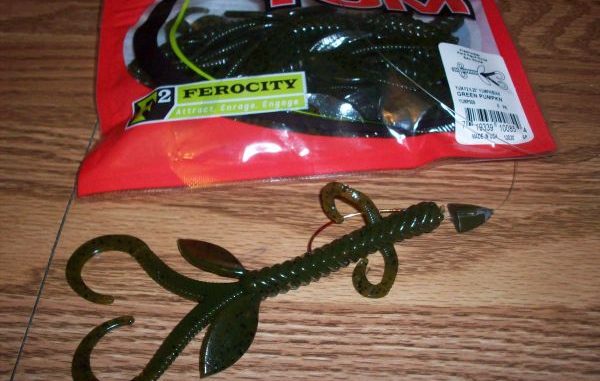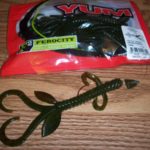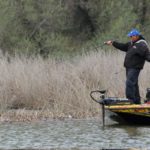
F2 Attractant makes YUMphibian a standout
Just look at those rows and rows and rows of soft-plastic creature baits, the success story of the 21st century, on the shelves at the main outlets and the local fishing tackle shops. It can be a mind-boggling challenge to pick up the right one(s).
How’s a man, or woman, to choose one that does the job — which is to get a bass to open its mouth and chomp on it?
YUM believes it has done that and more with the fairly new YUMphibian. Really, it isn’t run of the mill, said Lawrence Taylor, public relations director for YUM in Fort Smith, Ark.
Taylor offered some convincing credits for the creature bait and how it came to be a favorite this year among bass pros and weekend bass anglers alike.
“I think a lot of people look at creature baits as a lure you just throw legs and flappers and curl-tails on and call it good, but that’s not the case” with the YUMphibian, Taylor said Aug. 6. “We looked at the most-successful and effective creature baits on the market to determine how we could improve on the designs.
“One key to this type of bait is tremendous water disturbance; that is what initially gets the bass’ attention, but it needs to do so without being intimidating or creating a profile so far out there it turns off fish.”
Those were the goals designers focused on achieving.
“To accomplish this and maximize the lure’s attractiveness, we started with a slender, small-diameter body that is ridged to produce water disturbance,” Taylor said. “The ‘flappers’ toward the end of the bait are thick but stubby, again to maximize the disturbance and create the image of crawfish claws — but small enough so they aren’t a turn-off to bass when they come to investigate.
“Then the question of how to add even more vibration to maximize the attraction was answered with the two longer, very thin curl-tails on the back and the pair of small curl-tails near the head. These curl-tails produce water disturbance and add thump to the bait, but are so thin they aren’t a factor when fish approach. Because the plastic in these curl-tails is so thin they continue to move when the bait is at rest, like a crawfish’s antennae.”
Mission accomplished, Taylor and others said several weeks ago.
Texas bass-fishing guide and Bassmaster Elite Series pro Matt Reed certainly believes YUM has a winner with the YUMphibian. Reed said he has caught some 10-plus-pound bass on it this year while fishing his lakes in the Lone Star State.
And he’s chomping at the bit to duplicate that on the tour.
“It’s a great bait. It’s a great creature bait,” Reed said the first week of August. He had just got off the water from a guiding trip on Lake Falcon, where his biggest five bass went 38 pounds, all of which were caught on other artificial lures, he said matter-of-factly.
There are times and places galore for the YUMphibian, he knows all too well. There’s something extra-special about the latest creature bait to hit the market, he said.
Remember, it is a scent-infused soft plastic. Taylor called it a bonus, that F2. The package label reads: F2. Ferocity. Attract. Enrage. Engage.
“As a bonus we added F2 Attractant to the baits during the molding process, so not only do they release a realistic scent, but it also covers any unnatural smells from the angler’s hands,” Taylor said about the highly concentrated blend of enzymes and natural attractants scientifically proven to be the most-effective available.
Everything considered about its physical makeup, that attractant is the key to getting bit, according to Reed. The bass pro said he conducts Bass Pro Shops demonstrations during the winter and realized something right away when YUM started injecting F2 into its soft plastics.
“I noticed the difference when they switched to F2” Reed said. “Fish in the aquarium held onto it longer.
“Everybody has creature baits. One thing I think separates it is F2. That attractant in the plastic is very important.”
Reed, 50, first got his hands on YUMphibians around February. It quickly earned a spot in his bass-fishing repertoire.
“It’s a neat bait. It’s a real versatile piece of plastic. You can do just about anything you want to with it,” he said, quickly adding that his favorite ways to use it are Carolina rigging and flipping, the latter because “it has a lot of movement to it and it displaces a lot of water, and they (bass) know it’s there.”
What he likes about it, too, he said, is the fact it’s a fairly large soft plastic but there isn’t a lot of soft-plastic body there to foil a solid hookset.
But putting out the final product wasn’t easy, according to Taylor.
“It took a full year from design to production. Several designs were discarded along the way before we settled on this one,” he said, noting the product manufactured in the USA was truly a team effort involving professional bass anglers, engineers and others in the company.
As always, the first step was to bring the new shape or artificial lure design to the test tank, which often is the end for many ideas that don’t pan out.
“If it performs the way we want, samples are sent to pros and tested by staff,” he said. “If it passes these tests, the committee determines the number of sizes, colors, etc., before it is mass produced. We continue to test even after the bait is released to ensure what was approved is exactly what is being made.”
Taylor said response has been good since YUMphibians hit the market in June. He said reaction has been encouraging from both pro staffs and the bass-fishing public.
“Several of our pros have said they’ve caught fish on the bait. Response at the retail end is positive, as well,” he said. “With this bait, we’ve streamlined the color selection to just the ones that are most effective for waters that see a lot of creature baits.”
For more information on the YUMphibian and other YUM Bait Co. products, write to 3601 Jenny Lind Road, Fort Smith, Ark., 72901, or go to www.lurenet.com.




